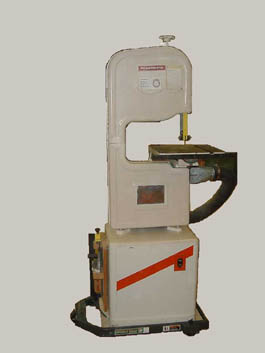Cutting on the Band Saw
|
|
The band saw is an all around tool. The band saw
can be used to cut many different types of cuts
that include: curved, irregular,
|
Controls: The controls on the circular saw in the materials processing laboratory consist of the following:
- A magnetic power switch that must be reset if the power in the laboratory is interrupted.
- A knob to loosen the saw blade guard and guide block assembly.
- A miter gauge for straight cuts.
- A handle to lock the table at the desired angle.
- A blade tension knob on top of the saw.
- A blade tracking knob on the back of the upper wheel guard.
Operation (Irregular or Curved Cuts):
Irregular or curved cuts is when a
piece of stock is moved around in a circular motion to
make a curve or square.
- First mark out the shape you want to cut on the stock to be sawed.
- Make sure the cutting surface is clutter free.
- Adjust the blade guard and guides so they 1/4" above the stock you are cutting.
- Turn the saw on and start to make your cut, if the curve is too sharp you may need to make relief cuts to allow for clearance.
- Finish the cut and turn the saw off and wait until the blade comes to a complete stop before removing any scraps.
|
|
|
|
Stock is being pushed into the blade. Note the position of the hands and the blade guards height above the stock. |
Again note the position of the hands away from the blade about 4". Only turn the stock while moving forward. |
Potential hazards: Because
the blade on the band saw is one continuous blade and for
the speed that it goes the follow hazards exist.
- Contact with the blade can cause serious injury.
- Loose clothing can get caught in the blade.
- The blade can break if twisted or pinched.
Safety practices: Because
of those potential hazards the following safety rules must
be followed.
- Only perform operations if you properly know how to use the machine.
- Make sure you are wearing safety glasses.
- Don't ware loose clothing that could be caught in the machine.
- Be sure to have a good hold of the stock.
- Make sure the blade is at the proper height 1/4" above the stock.
- Check the cutting surface for any foreign objects.
- Match the radius of the curve to the saw blade.
- Don't back out of long cuts
- Don't force the cut.
- Keep you fingers away from the blade, about 4î away.
- Be sure to have firm footing.
- Check the saw to make sure it is in good working order.
- Make all adjustments with the saw turned off, and unplugged in cases where the blade is or could be touched.
- Turn off the saw to clear any materials from near the blade.
- Avoid distractions, never look away during a cut.
- Do not allow others to crowd around the saw.
- Turn the saw off immediately if it does not sound right or if slivers of wood catch between the blade and table.
References:
Spence, William P., Griffiths, L. Duane (1981)
Woodworking: Tools,
Materials, Processes. American technical
Publishers Inc. Alsip,
Illinois.
Cliffe, Roger W. (1981) Woodworking Principles
and Practices. American
technical Publishers Inc. Alsip, Illinois.
ITT 252 - Materials Processing
Department of Technology
University of Southern Maine
Prepared by Jason Lanoie, 9/25/2001
